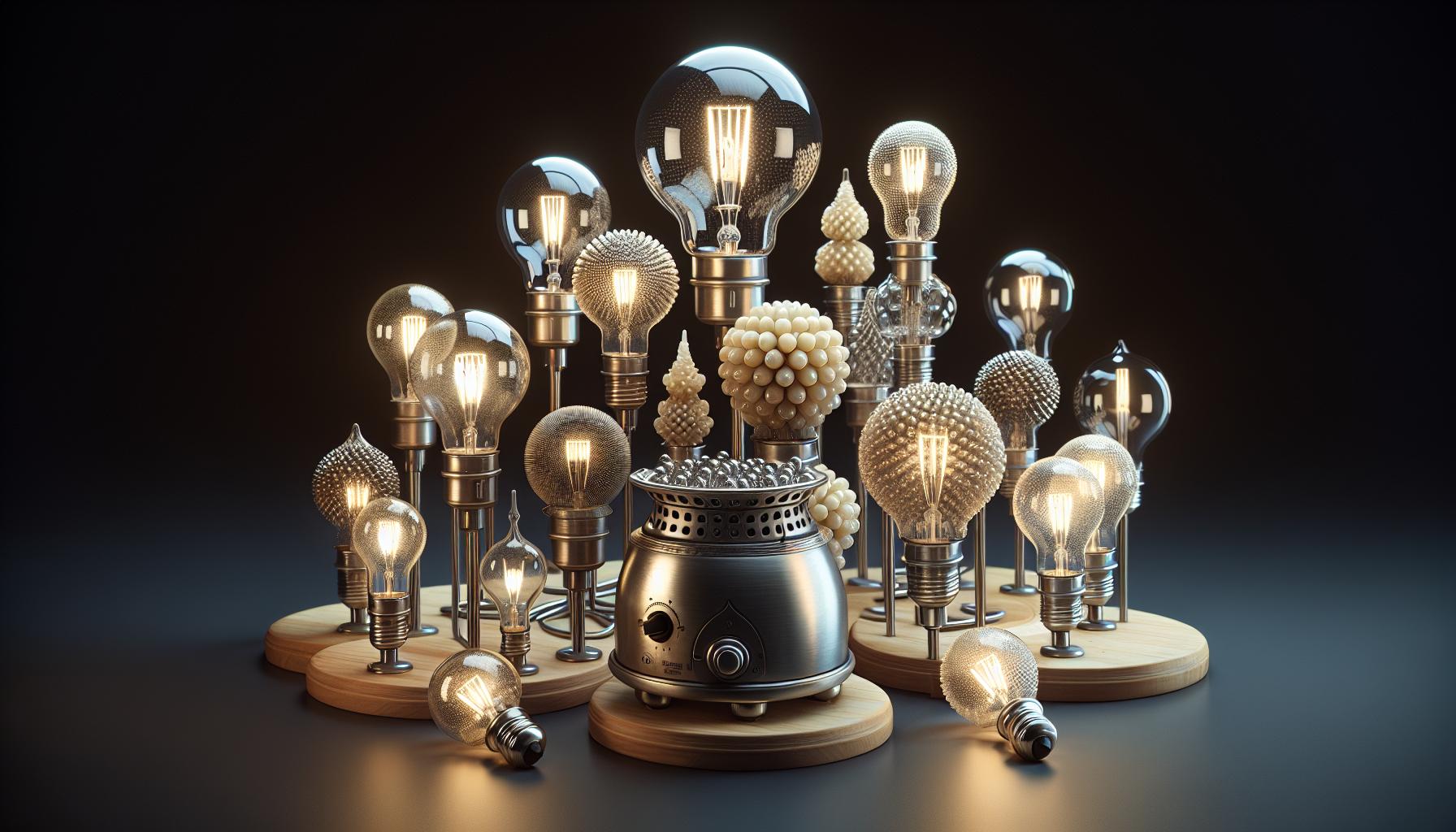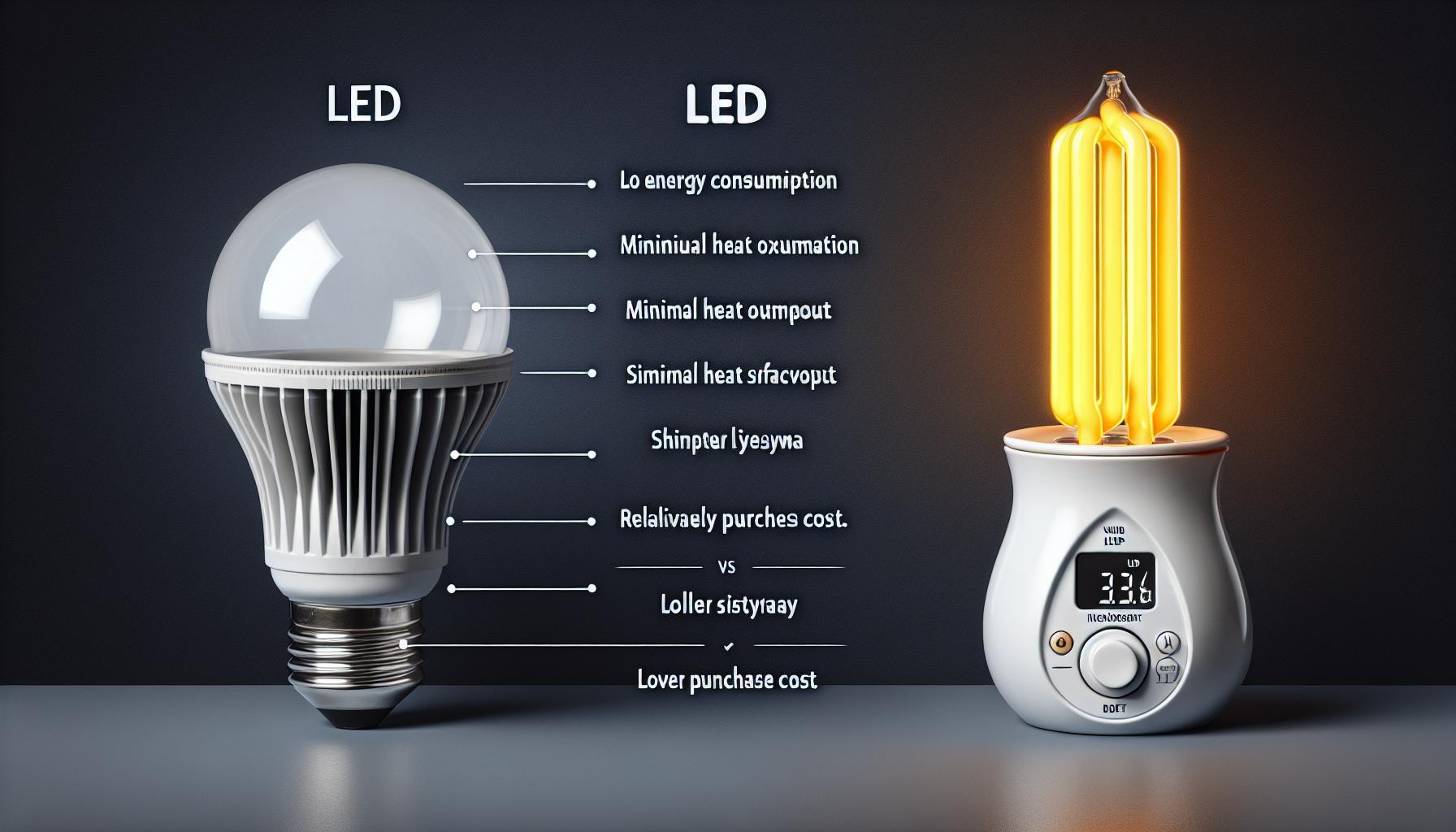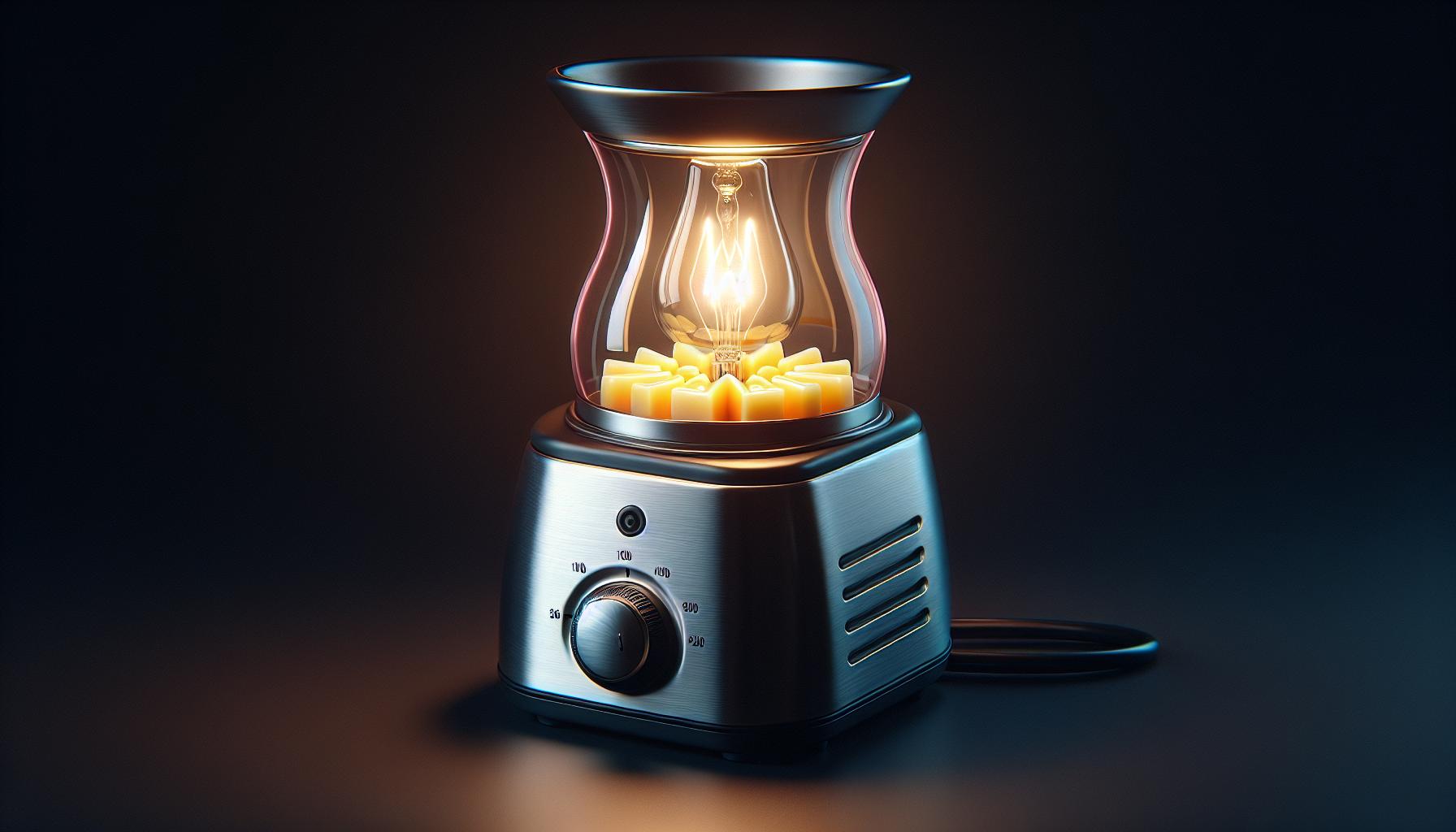Ever found yourself staring at the array of light bulbs in the store, wondering which one’s the perfect match for your wax warmer? You’re not alone. Choosing the right bulb is crucial, not just for ambiance but also for safety and efficiency.

You might think any bulb will do the trick, but there’s more to it. From wattage to bulb shape, the details matter. Let’s shed some light on the subject so you can enjoy your fragrant oasis without a hitch.
Why choosing the right light bulb for your wax warmer matters
When it comes to setting up your wax warmer, you might think any light bulb will do the trick. But as a lighting aficionado, you’ll soon discover that the magic lies in the details. The right bulb doesn’t just light up your warmer; it becomes the silent maestro of your space’s ambiance and mood.
Ambiance and Mood Lighting
Consider this: you’ve spent time selecting the perfect wax scent to fill your room. It’s not just about the fragrance; it’s about crafting an atmosphere. A bulb that’s too bright overshadows the subtle play of shadows and light, while one that’s too dim does little to showcase your warmer’s design. The correct wattage and bulb shape work in harmony to project just the right amount of light, creating a cozy and inviting space.
Safety First
Your safety is paramount. Unlike a simple lamp, your wax warmer combines heat with flammable materials. A bulb with a wattage too high can cause the wax to overheat, leading to potential fire hazards. Conversely, a bulb with too low a wattage won’t melt the wax properly, resulting in ineffective scent dispersion and a waxy buildup. For peace of mind, ensure that you’re using a bulb that complements the design and safety recommendations of your wax warmer.
Energy Efficiency
As a DIY pro, you’re also thinking about efficiency. An ideal light bulb will melt the wax thoroughly while conserving energy. Why not go for long-lasting LED bulbs that mirror the heat output of traditional bulbs? They’re cooler to the touch, better for the environment, and kinder to your electric bill.
Remember, harmony between your wax warmer and its bulb ensures optimal performance and extends the life of both. Next time you’re browsing the lighting aisle, armed with knowledge about wattage and shape, consider the impact of your choice. It’s not just a bulb; it’s an experience enhancer. Keep an eye out for the specifics that suit your warmer best and revel in the perfect melting moments that await.
Understanding wattage for wax warmers

When you’re cozying up your space with a wax warmer, the last thing you want is a bulb that’s too weak to melt your favorite scents or, on the flip side, one so strong it poses a safety risk. Wattage, essentially the measure of how much energy a bulb uses, directly impacts the heat produced by the light bulb. Getting this right is key to the efficient and safe operation of your wax warmer.
Most wax warmers are designed for bulbs ranging from 15 to 25 watts. It’s this sweet spot that provides just enough heat to melt the wax without reaching dangerous temperatures. Here’s what you should keep in mind:
- 15-Watt Bulb: Ideal for smaller wax warmers where less heat is sufficient to melt the wax. It’s gentle and won’t overpower a petite space.
- 20-Watt Bulb: A step up, and often the standard, providing a moderate level of heat that’s perfect for most average-sized wax warmers.
- 25-Watt Bulb: This wattage is best for larger rooms or wax warmers that have a bigger melting dish. It ensures the wax melts thoroughly and you get the full fragrance.
Remember that using the wrong wattage not only affects the functioning of your wax warmer but can also be a safety hazard. A bulb that’s too high in wattage may cause the wax to overheat, potentially leading to burns or even a fire. Conversely, a low-wattage bulb might leave you with partially melted wax and a lackluster scent throw.
Always check your wax warmer’s specifications before buying a replacement bulb. The manufacturer’s guidelines are there to ensure you get the optimal performance and maintain safety at the same time. If you’ve lost the manual, a quick online search with your model number can usually pull up the wattage requirements.
What’s more, energy-conscious homeowners might consider LED bulbs that mimic the heat output of traditional incandescents but use less energy and last longer. This way, you preserve the life of your wax warmer, save on electricity, and still indulge in the delightful aromas that make your space uniquely yours.
The right bulb shape for maximum fragrance release

When you’re setting the mood with your wax warmer, the bulb shape is another crucial player. Not all bulbs are created equal, and the shape can significantly affect how your wax melts and disperses scent.
« Where Do Light Bulbs Work Best? Discover Optimal Lighting for Every Space
How to Tell If Light Bulb Has Mercury – Spot it With This Guide »
Globe-shaped bulbs, like the G30 or G16.5, are designed to diffuse heat more evenly. This ensures that the entire wax surface receives consistent warmth which can help your favorite scents permeate the room more effectively. The spherical design of these bulbs means that warmth radiates in all directions which maximizes the efficiency of the wax melting process.
Tubular bulbs, particularly the T20 or T7 type, serve a different purpose. They’re typically narrower, focusing their heat more directly, which can be ideal for smaller wax warmers. The direct heat from tubular bulbs can create a more localized and intense fragrance experience which might be perfect for smaller spaces.
It’s not just about intensity; it’s about consistency as well.
- Consistent Heat: To avoid the overheating of wax, which can lead to fragrance loss, it’s essential that the bulb provides a uniform heat distribution.
- Even Melting: A bulb shape that allows for even melting of the wax ensures that all the wax is used and no fragrance is wasted.
- Uninterrupted Scent Flow: Bulbs promoting continuous melting won’t hinder the release of fragrance which keeps your space smelling wonderful.
Beyond shape, don’t forget to match the bulb base with your wax warmer’s socket. A mismatch here, and you could find yourself trying to fit a round bulb into a square hole – metaphorically speaking.
And remember, the aesthetics matter too. Your warmer is part of your decor, so choose a bulb that complements its style and adds to the ambiance of your room. Whether you prefer a vintage look with Edison bulbs or sleek with modern LED lights, make sure it’s serving both form and function in your wax warmer.
Choosing the right bulb shape isn’t just about what fits; it’s about enhancing your everyday life through scent and sensation.
LED vs. incandescent bulbs: Which one is better for wax warmers?

When you’re choosing between LED and incandescent bulbs for your wax warmer, it’s not just about flipping a switch; it’s about understanding the heat properties and efficiency that affect your aromatic experience. LED bulbs are known for their energy efficiency and long lifespan. They work by passing an electric current through a microchip, which illuminates the tiny light sources we call LEDs and results in visible light.
On the other hand, incandescent bulbs produce light by heating a wire filament to a temperature that makes it glow. This process requires more energy and the bulbs themselves do not last as long as LEDs. However, they generate more heat than LED bulbs, which can be beneficial for the melting process in a wax warmer.
Here’s what you need to weigh when deciding:
- Energy consumption: LEDs use about 75% less energy than incandescent bulbs. This means if you’re in the habit of enjoying your wax warmer frequently, you’ll save on your electricity bills with LEDs.
- Heat output: Wax warmers need heat to melt wax and release fragrance. Incandescent bulbs typically outperform LEDs in this area because they emit more heat.
- Bulb longevity: LEDs have a much longer lifespan, averaging up to 25,000 hours compared to incandescent bulbs’ 1,000 to 2,000 hours.
- Cost: LEDs tend to be more expensive upfront, but their efficiency and longevity can lead to savings over time.
| Feature | LED Bulbs | Incandescent Bulbs |
|---|---|---|
| Energy Consumption | Less (-75%) | More |
| Heat Output | Less | More |
| Average Lifespan (hours) | Up to 25,000 | 1,000 – 2,000 |
| Initial Cost | Higher | Lower |
Safety considerations when selecting a light bulb for your wax warmer

Safety is a top priority when choosing the right bulb for your wax warmer. Inappropriate bulb selection could lead to overheating, which is not just a hazard to the warmer itself, but to your home’s safety as well. Here are a few key points to keep in mind:
- Check the Maximum Wattage: Your wax warmer will have a maximum wattage rating, and it’s crucial that you stick to this limit. Using a bulb that exceeds this wattage can cause excessive heat, potentially leading to a fire hazard or damaging the warmer.
- Consider the Right Fit: Make sure the bulb base matches the warmer’s socket securely. A loose bulb might not only be less effective but can also pose a risk of electrical issues.
- Glass Quality Matters: Choose bulbs with high-quality glass that can withstand the heat generated by your wax warmer. Cheaper, low-quality glass may crack or shatter, especially if subjected to thermal shock after a cold draught.
- Ventilation Is Key: Ensure there’s proper air circulation around your wax warmer. Crowding it with flammable materials or placing it in a tightly confined space restricts airflow, increasing the risk of overheating.
Here’s a table summarizing the safe wattage ranges for different sizes of wax warmers:
| Wax Warmer Size | Safe Wattage Range |
|---|---|
| Small | 15 Watts |
| Medium | 20 Watts |
| Large | 25 Watts |
It’s also wise to regularly inspect the bulb and the warmer for any signs of damage. If you notice any blackening on the bulb or a frayed cord on the warmer, it’s time to replace them. Remember, prevention is better than cure, and routine checks can save a lot of trouble down the line.
While it’s tempting to pop in any old bulb you have lying around, taking the time to select the appropriate bulb goes a long way in ensuring your soothing ambiance remains a safe one. Keep these safety tips in mind and your wax warmer will be a worry-free source of fragrance and warmth in your home.
Conclusion
Now that you’ve got the lowdown on picking the perfect bulb for your wax warmer, you’re all set. Remember, it’s all about matching wattage to size and heat needs, choosing the right shape for even warmth, and ensuring the base fits snugly. Keep energy efficiency in mind with LED options and don’t forget to keep safety at the forefront. With these tips tucked away, you’re ready to create a cozy, fragrant ambiance in your home. Just follow the guidelines, keep an eye out for wear and tear, and enjoy the lovely, scented glow of your wax warmer.
Frequently Asked Questions
What is the ideal wattage range for light bulbs in wax warmers?
A typical light bulb for a wax warmer should range from 15 to 25 watts. The exact wattage depends on the size of the warmer and the desired heat output.
How does bulb shape affect the performance of a wax warmer?
Globe-shaped bulbs distribute heat more evenly which is better for consistent warming and scent dispersion, whereas tubular bulbs focus heat and are better suited for smaller wax warmers.
Can I use LED bulbs in my wax warmer for energy efficiency?
Yes, you can use LED bulbs in your wax warmer. They are known for their energy efficiency and can be a suitable alternative if they match the required wattage and fit.
Is it important to match the light bulb base with the wax warmer socket?
Absolutely, it’s essential to ensure that the bulb base matches the wax warmer’s socket to provide a proper and secure fit, which also ensures safe operation.
What are some safety considerations when choosing a light bulb for my wax warmer?
When choosing a bulb, check the maximum wattage of the wax warmer, ensure the bulb fits properly, opt for high-quality glass, and ensure that the warmer is well-ventilated.
How often should I inspect my wax warmer and the bulb for safety?
Regular inspections of both the bulb and wax warmer are important to identify any signs of damage or potential hazards. There’s no strict timeline, but checking before each use can be a good practice.




